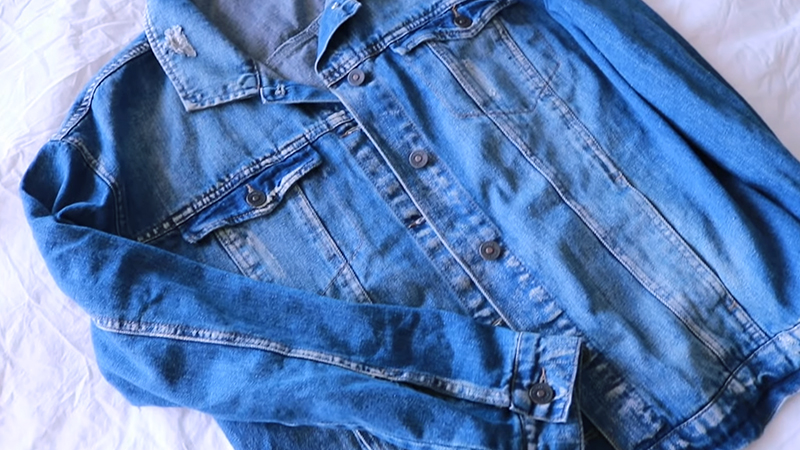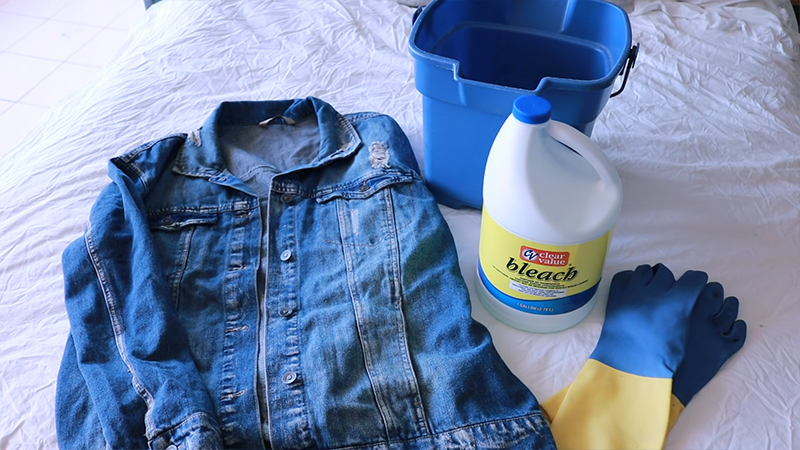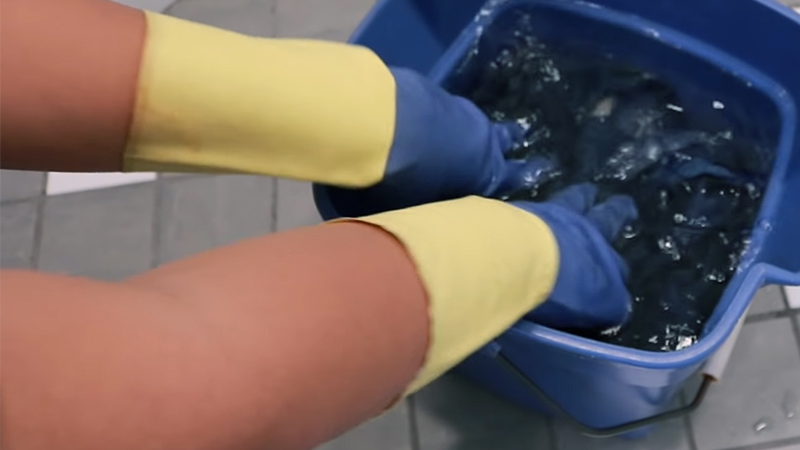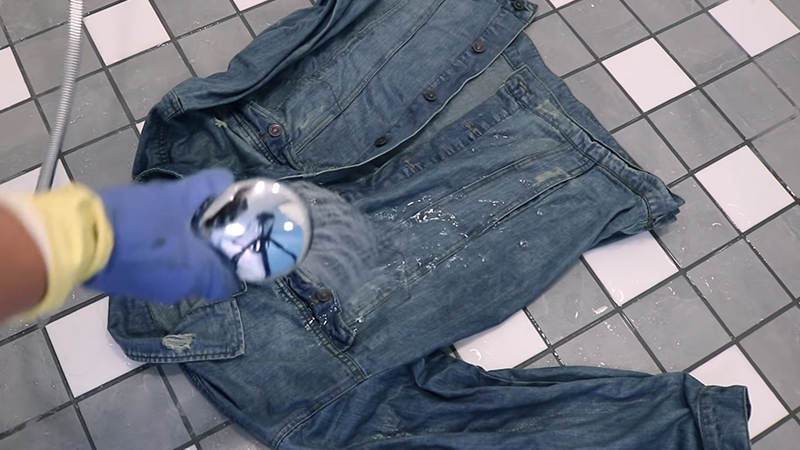Bleaching a denim jacket or jeans is a transformative DIY project that allows you to create unique, customized fashion pieces. Whether you’re looking to revamp an old favorite or add a personal touch to a new item, the process can be both creative and rewarding.
By strategically applying bleach, you can achieve a range of effects, from subtle fades to bold, eye-catching designs. However, this process requires careful attention to detail and safety precautions to ensure the best results.
In this guide, we will take you through the step-by-step process of bleaching denim, offering tips and insights to help you achieve the desired look while safeguarding your clothing and well-being.

What Is a Denim Jacket or Jeans?
A denim jacket is a timeless piece of outerwear crafted from sturdy cotton twill fabric known as denim. It typically features a button-up front, long sleeves, and chest pockets.
Denim jackets are celebrated for their versatility, seamlessly complementing various styles from casual to rugged. Jeans, on the other hand, are a type of pants also fashioned from denim fabric.
They are characterized by their sturdy, durable construction and are often recognized by their characteristic riveted pockets.
Jeans have become a global wardrobe staple, prized for their comfort and adaptability, making them suitable for a wide range of occasions and lifestyles.
How to Bleach Denim Jacket or Jeans?
Bleaching denim can be a fun and creative way to give your old denim jacket or jeans a fresh, customized look. Here’s a step-by-step guide on how to bleach a denim jacket or jeans:
Materials Needed:
- Denim Jacket or Jeans.
- Bleach.
- Plastic Bucket or Sink.
- Rubber Gloves.
- Water.
- Old Clothes or Apron.
- Spray Bottle.
Step-by-Step Instructions:
Choose a Well-Ventilated Area
Select a workspace with ample ventilation. This could be an outdoor area with a gentle breeze, or an indoor space with open windows and fans circulating air. Adequate ventilation is crucial to disperse bleach fumes and maintain a safe environment.
Prepare Your Work Area
Cover your work surface comprehensively with a plastic sheet or a layer of old towels. Ensure it extends beyond the dimensions of the denim piece. This protective layer not only shields your surroundings but also simplifies the cleanup process.
Dilute the Bleach
With caution, pour bleach into a plastic bucket or sink. The initial ratio of bleach to water depends on the desired effect. Starting with a 1:1 ratio provides a moderate lightening effect.
However, for more subtle results, a weaker mixture may be suitable. Always remember to wear rubber gloves to safeguard your hands from the bleach.
Test a Small Area
Prior to commencing the bleaching process, conduct a small-scale test on an inconspicuous part of the denim garment.
This trial run allows you to observe how the fabric reacts to the bleach mixture. Pay close attention to the color change and adjust the mixture accordingly.
Apply the Bleach
Now comes the application phase. There are two primary techniques:
- Dipping: Gently lower the entire jacket or jeans into the bleach mixture. Keep in mind that the duration of immersion will influence the degree of lightening. Ensure the denim is evenly submerged for uniform results.
- Spraying: If you prefer a controlled approach, use a spray bottle filled with the bleach mixture. Apply a light mist evenly across the denim surface. This method allows for a speckled or splattered effect, adding texture and character.
Monitor the Bleaching Process
Maintain a vigilant watch over the denim as it undergoes the bleaching process. This phase can transpire swiftly, especially if the fabric is thin or worn. Regular checks enable you to halt the process once the desired level of lightning is achieved.
Rinse Thoroughly
Once you’re satisfied with the color, gently lift the denim from the bleach mixture. Rinse it thoroughly under a stream of cold water.
The purpose of this step is to arrest the bleaching action. Optionally, a mild detergent can be used to ensure all traces of bleach are eradicated.
Wash and Dry
Subsequently, launder the denim separately in cold water. Use a mild detergent to preserve the fabric’s integrity. Post-washing, choose to either air dry the garment or opt for a low-heat tumble dry.
Assess and Repeat
Following the drying process, scrutinize the denim’s color. If you desire further lightening, consider reapplying the bleaching process. However, exercise caution to prevent over-bleaching, which can weaken the fabric.
Customize
For a unique touch, explore customization options. This could involve adding patches, intricate embroidery, or utilizing fabric paint. These personalized elements enhance the character of your newly bleached denim, reflecting your distinct style.
Post-Bleaching Care and Maintenance

After bleaching your denim jacket or jeans, proper post-bleaching care and maintenance are essential to ensure the longevity of your customized piece.
Here are some important steps to follow:
Rinse Thoroughly
After the bleaching process, ensure that you rinse the denim thoroughly one more time. This step is crucial to remove any residual bleach or detergent that may still be clinging to the fabric.
Thorough rinsing helps prevent the weakening of the fibers and ensures that no harmful chemicals remain.
Washing
When it’s time to wash your bleached denim, treat it with special care. Always wash it separately from other clothing items, especially darker colors, as there may still be a slight risk of color bleeding. Choose a gentle cycle and use cold water to maintain the integrity of the fabric.
Turn Inside Out
Preserve the custom design and color of your denim by turning it inside out before washing. This simple step minimizes friction and abrasion on the outer surface of the fabric, helping to retain the unique appearance you worked so hard to achieve.
Wash with Like Colors
When you’re washing multiple denim pieces, make sure they have similar colors to prevent any color bleeding. This precaution is especially important for the first few washes after bleaching, when there may be residual dye that could transfer to other items.
Gentle Cycle
Opt for a gentle or delicate cycle on your washing machine. Aggressive cycles can cause unnecessary wear and tear on the fabric. By choosing a milder cycle, you’re ensuring that your customized denim is treated with the utmost care.
Avoid Hot Water
Stick to cold water for washing. Hot water can cause the dye in the fabric to fade more rapidly, which can affect the overall look and color of your customized denim. Keeping the water temperature low helps to maintain the vibrancy of the fabric.
Skip the Dryer
Whenever possible, avoid using a dryer for your customized denim. Instead, opt for air drying by hanging it up or laying it flat.
This method minimizes the potential for heat-related damage and ensures that your denim maintains its integrity and shape.
Storage
Store your bleached denim in a cool, dry place away from direct sunlight. Sunlight and excessive heat can cause colors to fade and weaken the fabric over time.
By storing it in a controlled environment, you’re extending the life and vibrancy of your customized piece.
Avoid Overwashing
Denim doesn’t require frequent washing. In fact, washing it too often can lead to faster wear and color loss. Spot clean minor stains and only wash when absolutely necessary. This approach not only preserves the customized look but also prolongs the life of your denim.
Repair and Maintenance
Regularly inspect your denim for signs of wear, including fraying or small rips. Address any issues promptly by repairing them to prevent further damage. This proactive approach helps maintain the integrity of your customized denim for the long term.
Safety Precautions and Environmental Considerations

It’s important to consider both safety and environmental aspects when working with bleach.
Here are comprehensive safety precautions and environmental considerations for bleaching denim:
Ventilation
Ensure that the workspace you choose is well-ventilated. This is crucial for minimizing the inhalation of potentially harmful bleach fumes. Opening windows and using fans can significantly improve air circulation.
Personal Protective Equipment (PPE)
Don’t use rubber gloves before handling bleach. This provides a vital barrier between your skin and the bleach, preventing potential irritation or chemical burns.
Additionally, safety goggles or glasses are essential to safeguard your eyes from accidental splashes.
Clothing Protection
Select old, long-sleeved clothing or an apron to serve as an extra layer of protection. This not only shields your skin but also safeguards your regular clothes from any accidental bleach contact.
Avoid Skin Contact
In addition to gloves, opt for long sleeves and pants to further minimize the risk of direct contact with bleach. This precaution is especially important when working with potentially corrosive substances.
Test in a Small Area
Before applying bleach to the entire garment, conduct a patch test on an inconspicuous section of the denim. This preliminary test helps you gauge how the fabric will react to the bleach, ensuring you achieve the desired effect.
First Aid Preparedness
Keep a well-stocked first aid kit within easy reach. In the event of accidental skin contact or exposure, having immediate access to basic first aid supplies can make a significant difference.
Emergency Response Plan
Familiarize yourself with the steps to take in case of accidental ingestion, inhalation, or contact with bleach. Know the emergency contact numbers, including poison control, and keep them readily available.
Environmental Considerations:
Proper Disposal
Dispose of any leftover bleach and contaminated materials in accordance with local regulations. This ensures that potentially harmful chemicals are not released into the environment.
Minimal Use of Chemicals
Use only the amount of bleach necessary for the project. Avoid over-application, as this not only wastes resources but also minimizes the environmental impact associated with the production and disposal of bleach.
Avoid Overuse
Refrain from over-bleaching or reapplying bleach unnecessarily. Excessive use can weaken the fabric and contribute to unnecessary waste.
Consider Alternative Methods
Explore eco-friendly alternatives to bleach, such as natural dyes or fabric paints. These options allow for customization without relying on potentially harsh chemicals.
Reuse and Repurpose
Consider repurposing old denim items rather than discarding them. This promotes sustainability by extending the useful life of the fabric and reducing overall waste.
Choose Environmentally-Friendly Products
When possible, opt for eco-friendly bleach alternatives that have a reduced impact on the environment. These alternatives often use gentler ingredients that are less harmful to ecosystems.
Common Issues and How to Fix Them?

Bleaching denim can be a rewarding creative endeavor, but it’s not without its challenges.
In this section, we will explore some common issues that may arise during the bleaching process and provide practical solutions to help you troubleshoot and achieve your desired results.
Uneven Bleaching
- Issue: Sometimes, you may notice that the denim has unevenly lightened areas, resulting in a blotchy appearance.
- Solution: To avoid this, ensure consistent coverage during application. Use a consistent method, such as dipping or spraying, and maintain an even distribution of the bleach mixture.
- For post-bleaching, lightly scrubbing the uneven areas with a diluted bleach solution can help balance the color.
Over-Bleaching
- Issue: If you leave the denim in the bleach mixture for too long, it can become excessively faded, weak, or even damaged.
- Solution: Monitor the bleaching process closely, especially during the initial stages. Check the color regularly and remove the denim from the bleach mixture as soon as the desired level of lightening is achieved. If over-bleaching occurs, there is no way to reverse it, so prevention is key.
Bleach Spots and Splatters
- Issue: Bleach can inadvertently splatter or drip onto areas of the denim where it wasn’t intended.
- Solution: Act quickly if this happens. Rinse the affected area with cold water immediately to stop the bleaching action. If necessary, you can try spot-treating the affected area with a diluted bleach solution to even out the color.
Color Reversion or Dark Spots
- Issue: Sometimes, after bleaching, you may notice that the denim develops dark spots or that the original color reverts in certain areas.
- Solution: This issue can occur if the denim isn’t thoroughly rinsed and cleaned after bleaching. To prevent it, ensure that you rinse the denim thoroughly with cold water and use a mild detergent.
- If dark spots persist, you can try a gentle spot-cleaning method with a diluted bleach solution or consider re-bleaching the entire item for a more uniform look.
Fabric Weakening or Damage
- Issue: Prolonged exposure to bleach can weaken the fabric, leading to potential tears or holes.
- Solution: Prevent fabric damage by carefully monitoring the bleaching process and promptly removing the denim when you achieve the desired level of lightening.
- If damage occurs, you can patch or mend the affected areas to salvage your customized denim piece.
Incomplete Lightening
- Issue: After bleaching, you may find that the denim hasn’t lightened as much as you intended.
- Solution: To achieve a lighter color, you can reapply the bleaching process, focusing on the areas that need further lightening. Remember to thoroughly rinse and wash the denim between bleaching sessions to remove any residual bleach.
FAQs
How do I dilute bleach for bleaching denim?
Mix equal parts bleach and water in a plastic bucket or sink. Adjust the ratio depending on how light you want the final result to be.
Can I use a spray bottle for bleaching denim?
Yes, a spray bottle allows for controlled application. Fill it with the bleach mixture and lightly mist the denim for a speckled effect.
How long should I leave the denim in the bleach mixture?
Monitor the process closely. The time needed varies based on fabric thickness and desired lightness. Check regularly and remove when the desired effect is achieved.
Can I bleach colored denim?
Yes, but keep in mind that the original color may affect the outcome. Test a small area first to see how the bleach interacts with the existing color.
How should I wash and care for bleached denim afterward?
Wash separately in cold water with mild detergent. Avoid hot water and excessive heat in the dryer. Air drying is recommended to preserve the customized look.
To Recap
In the world of fashion, customizing denim jackets or jeans through bleaching is a creative endeavor that empowers individuals to express their unique style.
While the process may initially seem daunting, this guide has illuminated the steps and precautions needed to achieve the desired results safely.
From choosing a well-ventilated workspace to meticulously monitoring the bleaching process, attention to detail is key. By embracing experimentation and practicing patience, you can transform ordinary denim into a personalized fashion statement.
Remember, your bleached denim tells a story, reflecting your creativity and style, and it’s a testament to the endless possibilities that DIY fashion offers.
Leave a Reply